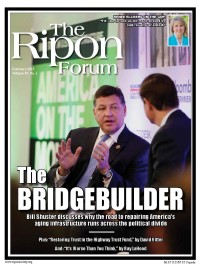 A new generation of highway and transit delivery is arriving, and private infrastructure developers are playing an expanding role. Private companies have designed and constructed highways and transit systems for decades. The new infrastructure developers do much more, including operating and maintaining facilities, and providing financing. Their profits depend on meeting contractual standards of quality and performance.
A new generation of highway and transit delivery is arriving, and private infrastructure developers are playing an expanding role. Private companies have designed and constructed highways and transit systems for decades. The new infrastructure developers do much more, including operating and maintaining facilities, and providing financing. Their profits depend on meeting contractual standards of quality and performance.
Key drivers of this new model have been emerging for some time. Governments face tight budgets, expanding retirement liabilities, and eroded political support for raising taxes.
Another driver is that transportation system users – motorists, fleet operators, transit passengers, etc. – increasingly expect facilities and vehicles to be bundled with information about operating conditions, reliability, and performance, delivered to their mobile devices or desktops. They expect 24/7 system monitoring, prompt incident response, and safe and reliable service.
Transportation system users increasingly expect facilities and vehicles to be bundled with information about operating conditions, reliability, and performance.
The menu of transportation services is also exploding. Self-driving cars may be here within the decade. Car sharing services Car2Go and Zipcar are expanding across the country and around the world. Uber and Lyft are disrupting the taxi industry. It’s now common to hail a ride in Paris, London, New York, San Francisco and China using the same app.
The staid world of parking is also in flux. Cell phone-based payment systems are now widespread. San Francisco’s downtown parking system adjusts prices in real time to keep some spaces available at all times and allow advanced booking.
Competition for street space is intense. Cities are squeezing bike lanes into existing street networks, and selectively repurposing street parking places to outdoor restaurant seating.
Transportation users are also changing. Millennials aren’t driving like Baby Boomers and Gen Xers did. We don’t yet know whether it’s because they prefer walking, transit and ridesharing, or because student loans and tough job markets keep them living with their parents and delaying marriage, kids and buying a car.
Aging Baby Boomers also want to maintain their quality of life if they become unable to drive themselves.
Most governments are not well suited to delivering these complicated bundles of infrastructure and services. Government procurement is difficult. Hiring and retaining the right talent is difficult. Annual funding cycles don’t suit large dollar projects. Deferred maintenance often leads to higher long term costs. And technological change is outpacing the procurement and construction cycle.
Another key factor is the emergence of global infrastructure developers that can deliver complex megaprojects on time (or early), within budget, and operate and maintain them at high levels of reliability and performance for decades. These firms are financing multi-billion dollar projects, and protecting government asset owners when things sometimes go wrong.
Most governments are not well suited to delivering these complicated bundles of infrastructure and services.
The benefits are already visible. Public-private partnerships (P3s) are delivering large, complex transportation projects ahead of schedule and below budget, in the U.S. and around the world. Virginia has delivered two new toll highway projects totaling $2.4 billion dollars, both ahead of schedule. Florida has delivered a $1.7 billion improvement to Interstate 595 near Ft. Lauderdale. Canada makes wide use of P3s for transportation as well as hospitals and public buildings. And experience with P3s is expanding around the globe. U.S. experience, while still limited, has generally prevented losses when they have occurred from being shifted to government.
P3s can’t solve all of our problems. Projects sometimes fail, investors and bondholders and governments sometimes lose. But our traditional ways of doing business are failing, too. Think Big Dig, the 30-plus year project to build a highway under Boston that was nearly crippled by traditional procurement, political interference and massive cost overruns.
Government plays a critical role. It owns the physical assets, has responsibility for oversight and monitoring, and usually provides some of the funding.
Government also creates the policy environment that is crucial to P3s’ success. Thirty-three states now have P3 statutes. The U.S. is likely to be the largest P3 market in the world in the coming decade. But that requires a fair and transparent policy environment.
Government agencies and elected officials must maintain careful oversight and remove barriers to better ways of doing the public’s business. This won’t be easy –some of these barriers are deeply entrenched.
But it’s important. It’s a better way of doing business, and a better way of ensuring our prosperity and quality of life.
Jonathan Gifford is the director of the Center for Transportation Public-Private Partnership Policy at George Mason University (jgifford@gmu.edu, p3policy.gmu.edu, @P3policy).




